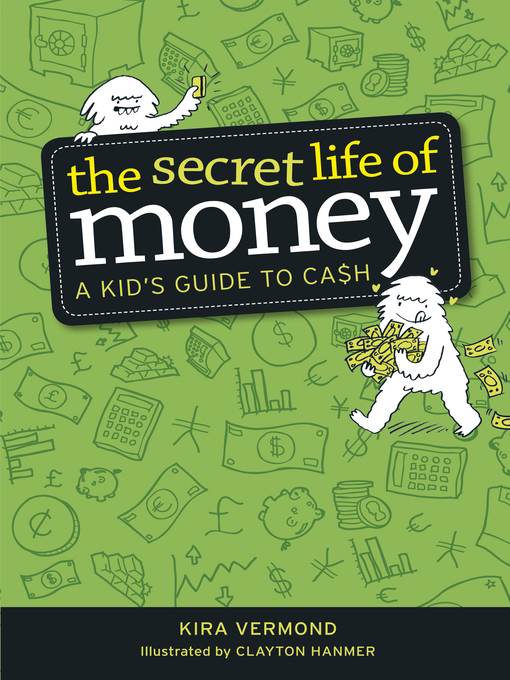
The Secret Life of Money
A Kid's Guide to Cash
فرمت کتاب
ebook
تاریخ انتشار
2014
Lexile Score
920
Reading Level
4-5
ATOS
6.2
Interest Level
4-8(MG)
نویسنده
Samantha Edwardsناشر
Owlkids Books Inc.شابک
9781926973203
کتاب های مرتبط
- اطلاعات
- نقد و بررسی
- دیدگاه کاربران
نقد و بررسی

January 23, 2012
“Cash is complicated, but in a seriously fascinating way. It makes us happy, sad, fearful, and even embarrassed.” Casual yet comprehensive, this informative guide to money presents the basics behind earning, saving, and spending wisely, while providing a crash course in economics. Employment, credit ratings, stocks, taxes, and investment (“Time... is also one of the most important ingredients to investment success. And that’s why you age makes you an incredibly powerful force”) are all discussed in clear, concise sections featuring cartoon spot art of impish characters, while concepts like inflation, economic bubbles, and microloans are illustrated in comic panels. Interviews with bankers, entrepreneurs, and other experts offer real-world background on some of the topics discussed. Readers landing a first job or opening a bank account should find insightful tips for developing a healthy and levelheaded relationship with money. Ages 9–13.

February 1, 2012
This chatty guide to money works to make the subject appealing to middle-schoolers but is regrettably short on sourcing. Vermond first defines what money is: More than just dollars and cents, money is "an agreement between people in an economy." Since we can't steal the things we need, she explains, there are multiple ways to make money. Money can be earned by jobs that reward workers for their time and special skills. Alternatively, you could be an entrepreneur and take on the risk and rewards of starting your own business. Of course, there's also imaginary money, aka credit, and its associated perils of debt and interest. The importance of saving is highlighted, from simple self-control and delayed gratification to investing and the advantage of compound interest. The text zips along, accompanied by two-color line art and frequent sidebars, with information on such topics as ancient money and interviews with financial experts. The author has a talent for explaining finance in an enthusiastic, easy-to-understand manner, yet with no works cited or references listed, there are questions about where these facts and figures come from. A good guide for beginners and browsers, but not suitable for research. (glossary, index) (Nonfiction. 10-14)
COPYRIGHT(2012) Kirkus Reviews, ALL RIGHTS RESERVED.

April 1, 2012
Gr 6-10-Vermond gives practical advice, but, more importantly, explores the emotional and social role of money in teens' lives, both culturally and personally. She incorporates the basics on earning, saving, and investing. She explains why people work, with entertaining lab-rat anecdotes, and explains how the reasons impact earnings and the machinations of society. Vermond tells readers that there are infinite ways to earn money, with a whole chapter devoted to early onset (middle school onwards) entrepreneurial endeavors, the bottom line being that readers should earn through a job that inspires them, or for which they have a particular talent. This book is framed around the psychology of earning without being pedantic; in fact, it is full of cartoon concept-expansion sidebars. The author has an engaging, snappy tone and lays out sophisticated financial concepts in an accessible fashion. Speaking of fashion, she uses ample clothes-buying examples to hook tween and teen readers. She shares socially conscious consumer tips, advocates saving, and discusses poverty and "the poor" and why we should care about them. She goes global, skimming the surface of poverty, charities, microloans, and the World Bank and IMF, promoting the positive psychology of altruism. Based on the psychology of earning and spending, the book presents such fascinating concepts as neuromarketing, market bubbles, brand recognition, and behavioral economists. This is a perceptive and timely publication on financial literacy for a new generation.-Meredith Toumayan, Langley-Adams Library, Groveland, MA
Copyright 2012 School Library Journal, LLC Used with permission.

May 1, 2012
Grades 7-10 Operating under the mindset that financial literacy (that's fancy for money education') is something everyone should have access to a lot earlier in life, this primer sets out to inform kids about the serious financial decisions they'll undertake (or might even already be undertaking) in their lives. Vermond clearly finds the topic fascinating, and her informal and approachable text, which doesn't sacrifice solid information in the name of chattiness, may help win over readers who might otherwise shudder at the mention of compound interest, subprime lending, or credit rating. She provides evenhanded discussions of income inequality, marks the distinction between consumerism and consumption, and talks about how debt can be both a good and bad thing. A report on the global economy, ideas for kick-starting savings accounts, and a chapter on raising money for charity round out this helpful offering. Hanmer's cartoon illustrations add an extra dollop of humor.(Reprinted with permission of Booklist, copyright 2012, American Library Association.)

























دیدگاه کاربران